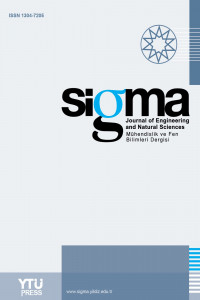OPTIMIZATION OF CUTTING PARAMETERS USING THE RESPONSE SURFACE METHOD
Abstract
Some cutting parameters have to be considered in order to obtain high-quality surfaces in machining. Because poorly selected cutting parameters cause both the cutting tools to wear out quickly and the surface to become rough. Therefore, it is of great importance to use experimental design methods to obtain better quality surfaces with an optimal combination of cutting parameters.
In this study, optimization of cutting parameters such as feed rate, cutting speed and depth of cut, which affects the surface roughness of AISI 1040 steel the commonly used in the industry, is aimed by three-level Box-Behnken design combined with response surface methodology. For this purpose, 15 workpieces with ∅ 70 mm and 200 mm length were prepared and machined on a CNC lathe. Then, the surface roughness values of the workpieces were measured. The obtained surface roughness values were analyzed in the Design Expert 10.0.6 program and the cutting parameters affecting the surface roughness were optimized. According to the results obtained from the study, it was determined that the feed rate is the parameter that has the greatest effect on the surface roughness. In addition, optimum surface roughness was determined by a feed rate of 0.2 mm/rev, a cutting speed of 397.58 m/min and a depth of cut 1.5617 mm.
References
- [1] Aktaş, S., Çiftçi, E. (2015). Hasta memnuniyetine yanıt yüzeyi yaklaşımı, EJOSAT:European Journal of Science and Technology, 2(4), 128-135.
- [2] Gunay, M. (2008). Investigation of the interaction between the surface quality and rake angle in machining of AISI 1040 steel, Sigma-Journal of Engineering and Natural Sciences, 26(2), 105-111.
- [3] Türkşen, Ö., Apaydın, A. (2012). Bulanık yaklaşım ile çok yanıtlı yüzey problemlerinin modellenmesi ve optimizasyonu, Anadolu Üniversitesi Bilim ve Teknoloji Dergisi-A, 13(1), 65-79.
- [4] Aslan, N., Cebeci, Y. (2007). Application of Box–Behnken design and response surface methodology for modeling of some Turkish coals, Fuel, 86(1), 90-97.
- [5] Baş, C. Cevap yüzeyi tasarımları ve sinir ağları yaklaşımı, Ankara Üniversitesi Fen Bilimleri Enstitüsü, Doktora Tezi, Ankara, 2010.
- [6] Kavak, N. (2012). AISI 1040 çeliğinin kuru tornalanmasında yüzey pürüzlülüğünün incelenmesi, Karaelmas Fen ve Mühendislik Dergisi, 2(2), 24-29.
- [7] Özses, B. Bilgisayar sayısal denetimli takım tezgahlarında değişik işleme koşullarının yüzey pürüzlülüğüne etkisi, G.Ü. Fen Bilimleri Enstitüsü,Yüksek Lisans Tezi, Ankara, 2002.
- [8] Ng, K. W., Raman, S. Forces, surface error and path length in tool path selection, Proceedings of the 1997 Sixth Annual Industrial Engineering Research Conference, Miami Beach, FL, USA, 948-953, 1997.
- [9] Gökkaya, H., Sur, G., Dilipak, H. (2004). PVD ve CVD kaplamalı sementit karbür kesici takımların işleme parametrelerine bağlı olarak yüzey pürüzlülüğüne etkisinin deneysel olarak incelenmesi, Z.K.Ü. Karabük Teknik Eğitim Fakültesi Teknoloji Dergisi, 7(3), 473-478.
- [10] Taguchi, G., Konishi, S. Orthogonal arrays and linear graphs, American Supplier Institute, Miami, A.B.D., 1987.
- [11] Kılıçkap, E., Hüseyinoğlu, M. (2010). Tepki yüzey modeli ve genetik algoritma kullanılarak AISI 316’nın delinmesinde oluşan çapak yüksekliğinin modellenmesi ve optimizasyonu, Dicle Üniversitesi Mühendislik Fakültesi Dergisi, 1(1), 71-80.
- [12] Erşan, M., Açıkel, Ü. R. (2014). Delemar’ın asit fosfataz üretimi ve Zn(Iı) biyobirikiminin cevap yüzey yöntemi kullanarak optimize edilmesi, Gazi Üniversitesi Mühendislik-Mimarlık Fakültesi Dergisi, 29(2), 321-329.
- [13] Montgomery, D. C. Design and analysis of experiments, 5th Edition, John Wiley & Sons, Inc., New York, 2001.
- [14] Çilek E. C. (2013). Mineral flotasyonu, Süleyman Demirel Üniversitesi Mühendislik Fakültesi Yayın No:59, 165.
- [15] Öztürk, Z. B., Nuran, A. Y. (2012). Yanıt yüzey metodu ile porselen karo küçülmesinde ergiticilerin optimizasyonu, Journal of Engineering and Architecture Faculty of Eskişehir Osmangazi University, 25(2), 57-65.
- [16] Öney, Ö., Samanlı, S. (2017). Kütahya/Altıntaş grafitlerinin kaba flotasyon parametrelerinin box-behnken deney tasarımı kullanılarak optimizasyonu ve modellenmesi, Dokuz Eylul University-Faculty of Engineering Journal of Science and Engineering, 19(56), 532-542.
- [17] Koç, B., Kaymak-Ertekin, F. (2010). Yanıt yüzey yöntemi ve gıda işleme uygulamaları, Gıda Dergisi, 35(1), 1-8.
- [18] Myers, R. H., Montgomery, D. C. (2002). Response surface methodology process and product optimization using designed experiments, John Wiley and Sons, New York.
- [19] Box, G. E. P., Draper, N. R. (2007). Response surface mixtures and ridge analysis, John Wiley and Sons, New Jersey.
- [20] Erdoğan, F. (2007). Yükseltilmiş D-Optimal dizayn yöntemi kullanılarak mühendislik dizaynlarında etkinliğin geliştirilmesi: ‘sentetik jet’ dizayn optimizasyon çalışması, Havacılık ve Uzay Teknolojileri Dergisi, 3(1), 51-61.
- [21] Myers, R. H., Montgomery, D. C., Anderson-Cook, C. M. Response surface methodology: process and product optimization using designed experiments, John Wiley & Sons, Inc, 2016.
- [22] Erler, E., Akçayöz, E., Tuncer, İ. H. Sentetik jet parametrelerinin eliptik profil ve kanat kesidi üzerindeki akışın kontrolü için yanıt yüzeyi yöntemi ile eniyileştirilmesi, II. Ulusal Havacılık ve Uzay Konferansı UHUK-2008-030, 15-17 Ekim 2008, İTÜ, İstanbul.
- [23] Köksoy, O. Taguchi ve cevap yüzey felsefelerinin birleştirilmesi: Problem ve çözüm stratejileri, Hacettepe Üniversitesi Fen Bilimleri Enstitüsü, Doktora Tezi, Ankara, 2001.
- [24] Tania, P., Deborah, J. S. (2002). An annotated bibliography of application papers using certain classes of fractional factorial and related designs, Journal of Statistical Planning and Inference, 106, 245-269.
Details
| Primary Language | English |
|---|---|
| Subjects | Engineering |
| Journal Section | Research Articles |
| Authors | |
| Publication Date | March 1, 2018 |
| Submission Date | July 28, 2017 |
| Published in Issue | Year 2018 Volume: 36 Issue: 1 |
IMPORTANT NOTE: JOURNAL SUBMISSION LINK https://eds.yildiz.edu.tr/sigma/

